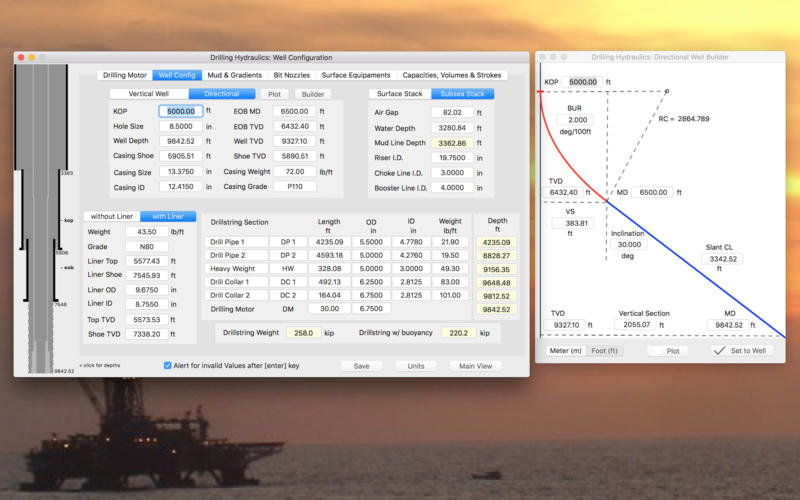Calculate pressure profiles, ECD, Swab & Surge, Hole cleaning for drilling and tripping operations.
Drilling mud leaves the pump discharge, passes through the surface lines, standpipe, and mud hose, and finally enters the drill string at the top of the kelly joint. Here it begins the long downward travel through the drill pipe and drill collars, is expelled through the water courses or nozzles of the bit, and returns up the annulus?. WELLBORE HYDRAULICS Calculate pressure profiles, ECD, Swab & Surge, Hole cleaning for drilling and tripping operations. The pressure losses associated to the mud circulation must be considered carefully for every operation.
The pressure losses associated to the mud circulation must be considered carefully for every operation. An incorrect estimation of the pressure profiles in the well can lead to major problems such as formation fracturing, as well as our gas for fluid influx… The Wellbore Hydraulics module takes into account these friction phenomena.
Learn more about our full suite to best suit your needs.
See just how easy it is to get started with DrillScan's software.
Fluid flow can do some pretty amazing things, from cutting precise lines in steel to forming the Grand Canyon – it all depends on how much, where, and how fast. In this Drilling Minute, we’ll learn how mud flow is optimized for PDC drilling with bit hydraulics.
Bit hydraulics is simply how drilling hydraulics is manipulated by the bit. PDC drilling creates a lot of damaging heat, so one goal of bit hydraulics is to keep the cutters cool. It also has to clean the hole and the bit, which turns out to be an important distinction.
Drilling Hydraulics Software
Cuttings Evacuation
Cleaning the hole really means evacuating the cuttings. Just like digging a hole with a shovel, it’s hard to make progress if the hole is filled with cuttings. Cleaning the bit is more like removing clay stuck to a shovel. Both of these problems make digging – and drilling – less efficient, but you do different things to fix them.

Just like large tidal wave can easily move massive objects, you need a lot of volume, or flow rate, to evacuate a lot of cuttings and carry them up the hole. A rule of thumb for the minimum flow rate needed to keep the hole clean is one barrel per minute per inch of bit diameter, but more should be used to ensure evacuation at higher ROP.
With all of the cuttings out of the hole, we still need to keep the bit clean. In the example of clay stuck to a shovel, we wouldn’t clean it by just running water over it; we would spray it with more power by putting our thumb over the end of the hose. In the same way, we can adjust the power at the nozzles by changing them. A good rule of thumb is to keep HSI, hydraulic horsepower per square inch, between 1 and 4 to balance between good cleaning and damaging erosion.
Drilling Hydraulics Program
TFA
At a given flow rate, we adjust hydraulic power by changing the total flow area, or TFA. One way is to redesign the bit with more or fewer nozzles, but TFA can also be changed in the field by using different size nozzles. Handy charts are available that give TFA for different nozzle sizes and counts. With the mud properties, flow rate and TFA, you can calculate HSI and pressure drop across the bit.
It is important to remember that hydraulic variables all work together and have to balance out. You want to pump more than enough flow to clean the hole, and you also want to keep TFA low enough to keep the bit clean. But both of these things can be limited by the pump pressure available.

Optimizing bit hydraulics in the field is important because so many variables can change, but where those nozzles are placed and pointed is also important, which is the topic of the next Drilling Minute.
